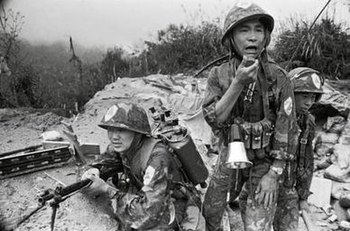Sino-Vietnamese conflicts 1979-90
| Sino-Vietnamese conflicts, 1979–90 | |||||||||
|---|---|---|---|---|---|---|---|---|---|
| Part of the Third Indochina War and the Cold War | |||||||||
 A Chinese officer reports to his command after a battle against Vietnamese forces on 14 October 1986 |
|||||||||
|
|||||||||
| Belligerents | |||||||||
|
|
|
||||||||
| Commanders and leaders | |||||||||
|
Chairman of the SCNPC (1979–83) President (1983–88) President (1988–90) |
General Secretary (1979–86) General Secretary (1986) Chairman of the CS (1981–87) General Secretary (1986–90) President (1979–80) President (1980–81) Chairman of the CS (1987–90) |
||||||||
| Strength | |||||||||
| ~200,000–400,000 | ~600,000–800,000 (including irregular units) | ||||||||
| Casualties and losses | |||||||||
| Several thousands killed | |||||||||
The Sino-Vietnamese conflicts of 1979–90 were a series of border and naval clashes between the People's Republic of China and the Socialist Republic of Vietnam following the Sino-Vietnamese War in 1979. These clashes lasted from the end of the Sino-Vietnamese War until 1990.
When the Chinese People's Liberation Army (PLA) withdrew from Vietnam in March 1979 after the war, China announced that they were not ambitious for "any square inch of the territory of Vietnam". In fact, Chinese troops occupied an area of 60 square kilometres (23 sq mi), which was disputed land controlled by Vietnam before hostilities broke out. In some places such as the area around Friendship Gate near the city of Lạng Sơn, Chinese troops occupied territories which had little military value but important symbolic value. Elsewhere, Chinese troops occupied the strategic positions of military importance as springboards to attack Vietnam.
The Chinese occupation of border territory angered Vietnam, and this ushered in a series of fights between the two sides to gain control of the area. Border conflicts between Vietnam and China continued until 1988, peaking in the years 1984–1985. By the early 1990s, along with the withdrawal of Vietnam from Cambodia and the dissolution of the Soviet Union, the relationship between the two countries gradually returned to normality.
After 1979, there were at least six clashes on the Sino-Vietnamese border in June and October 1980, May 1981, April 1983, April 1984, June 1985, and from October 1986 to January 1987. According to Western observers, all were initiated or provoked by the Chinese to serve their political objectives. The imminent threat of another invasion by the northern neighbor impelled Vietnam to build up an enormous defending force. During the 1980s, around 600,000–800,000 Vietnamese regulars and paramilitaries were estimated to have been present in frontier areas, confronted by some 200,000–400,000 Chinese troops.
Throughout the conflict, the Vietnamese Vị Xuyên District had become the most violent front, which had entangled many interchanged units from both sides. According to cursory examination, seven divisions (313th, 314th, 325th, 328th, 354th, 356th, and 411th) and one separate regiment (266th/341st) among Vietnamese forces used to be involved in this battlefield in the mid-1980s. On the Chinese side, armies from seven military regions had been rotated through this area to "touch the tiger's butt", an implication of obtaining combat experiences given by Chinese paramount leader, Deng Xiaoping. From 1984 to 1989, at least 14 Chinese armies had been substitutionally committed to the fight in the area (1st, 12th, 13th, 14th, 16th, 20th, 23rd, 26th, 27th, 38th, 41st, 42nd, 47th, and 67th).
...
Wikipedia
